Project Cost Estimation, Implementation, and Schedule Analysis Report
VerifiedAdded on 2020/05/11
|18
|3523
|34
Report
AI Summary
This report delves into the critical aspects of project cost estimation, emphasizing its significance for successful project management. It explores both top-down and bottom-up approaches to cost estimation, highlighting the importance of accurate resource allocation and timely project completion. The report discusses various cost categories, including direct, indirect, fixed, and variable costs, and defines concepts such as white elephants. It also examines the role of Work Breakdown Structure (WBS) and its link to project networks, underscoring the need for a well-defined scope. Furthermore, the report explains the concepts of slack, lead time, lag time, and hammock activities, emphasizing their importance in project scheduling and flexibility. The implementation plan outlines the steps to achieve project goals, including task names, durations, and predecessors. The report recommends merging related tasks and reducing the duration of meetings to save time. Finally, it presents a detailed project budget estimate, outlining the costs associated with various project components, such as salaries, equipment, and materials.

Name of student:
Registration number:
Unit Code:
Unit Title:
Subject supervisor name:
Date due:
Registration number:
Unit Code:
Unit Title:
Subject supervisor name:
Date due:
Paraphrase This Document
Need a fresh take? Get an instant paraphrase of this document with our AI Paraphraser
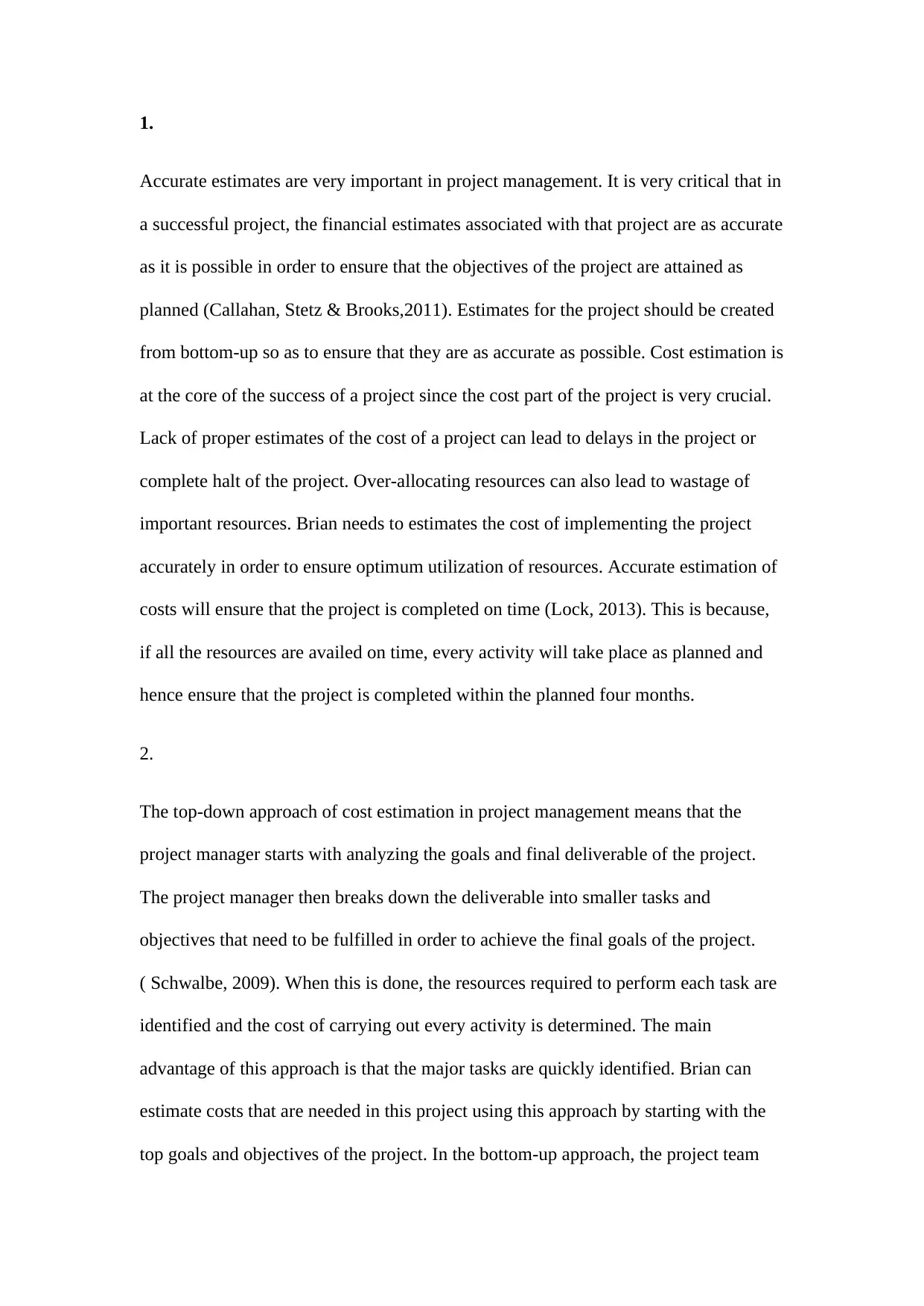
1.
Accurate estimates are very important in project management. It is very critical that in
a successful project, the financial estimates associated with that project are as accurate
as it is possible in order to ensure that the objectives of the project are attained as
planned (Callahan, Stetz & Brooks,2011). Estimates for the project should be created
from bottom-up so as to ensure that they are as accurate as possible. Cost estimation is
at the core of the success of a project since the cost part of the project is very crucial.
Lack of proper estimates of the cost of a project can lead to delays in the project or
complete halt of the project. Over-allocating resources can also lead to wastage of
important resources. Brian needs to estimates the cost of implementing the project
accurately in order to ensure optimum utilization of resources. Accurate estimation of
costs will ensure that the project is completed on time (Lock, 2013). This is because,
if all the resources are availed on time, every activity will take place as planned and
hence ensure that the project is completed within the planned four months.
2.
The top-down approach of cost estimation in project management means that the
project manager starts with analyzing the goals and final deliverable of the project.
The project manager then breaks down the deliverable into smaller tasks and
objectives that need to be fulfilled in order to achieve the final goals of the project.
( Schwalbe, 2009). When this is done, the resources required to perform each task are
identified and the cost of carrying out every activity is determined. The main
advantage of this approach is that the major tasks are quickly identified. Brian can
estimate costs that are needed in this project using this approach by starting with the
top goals and objectives of the project. In the bottom-up approach, the project team
Accurate estimates are very important in project management. It is very critical that in
a successful project, the financial estimates associated with that project are as accurate
as it is possible in order to ensure that the objectives of the project are attained as
planned (Callahan, Stetz & Brooks,2011). Estimates for the project should be created
from bottom-up so as to ensure that they are as accurate as possible. Cost estimation is
at the core of the success of a project since the cost part of the project is very crucial.
Lack of proper estimates of the cost of a project can lead to delays in the project or
complete halt of the project. Over-allocating resources can also lead to wastage of
important resources. Brian needs to estimates the cost of implementing the project
accurately in order to ensure optimum utilization of resources. Accurate estimation of
costs will ensure that the project is completed on time (Lock, 2013). This is because,
if all the resources are availed on time, every activity will take place as planned and
hence ensure that the project is completed within the planned four months.
2.
The top-down approach of cost estimation in project management means that the
project manager starts with analyzing the goals and final deliverable of the project.
The project manager then breaks down the deliverable into smaller tasks and
objectives that need to be fulfilled in order to achieve the final goals of the project.
( Schwalbe, 2009). When this is done, the resources required to perform each task are
identified and the cost of carrying out every activity is determined. The main
advantage of this approach is that the major tasks are quickly identified. Brian can
estimate costs that are needed in this project using this approach by starting with the
top goals and objectives of the project. In the bottom-up approach, the project team
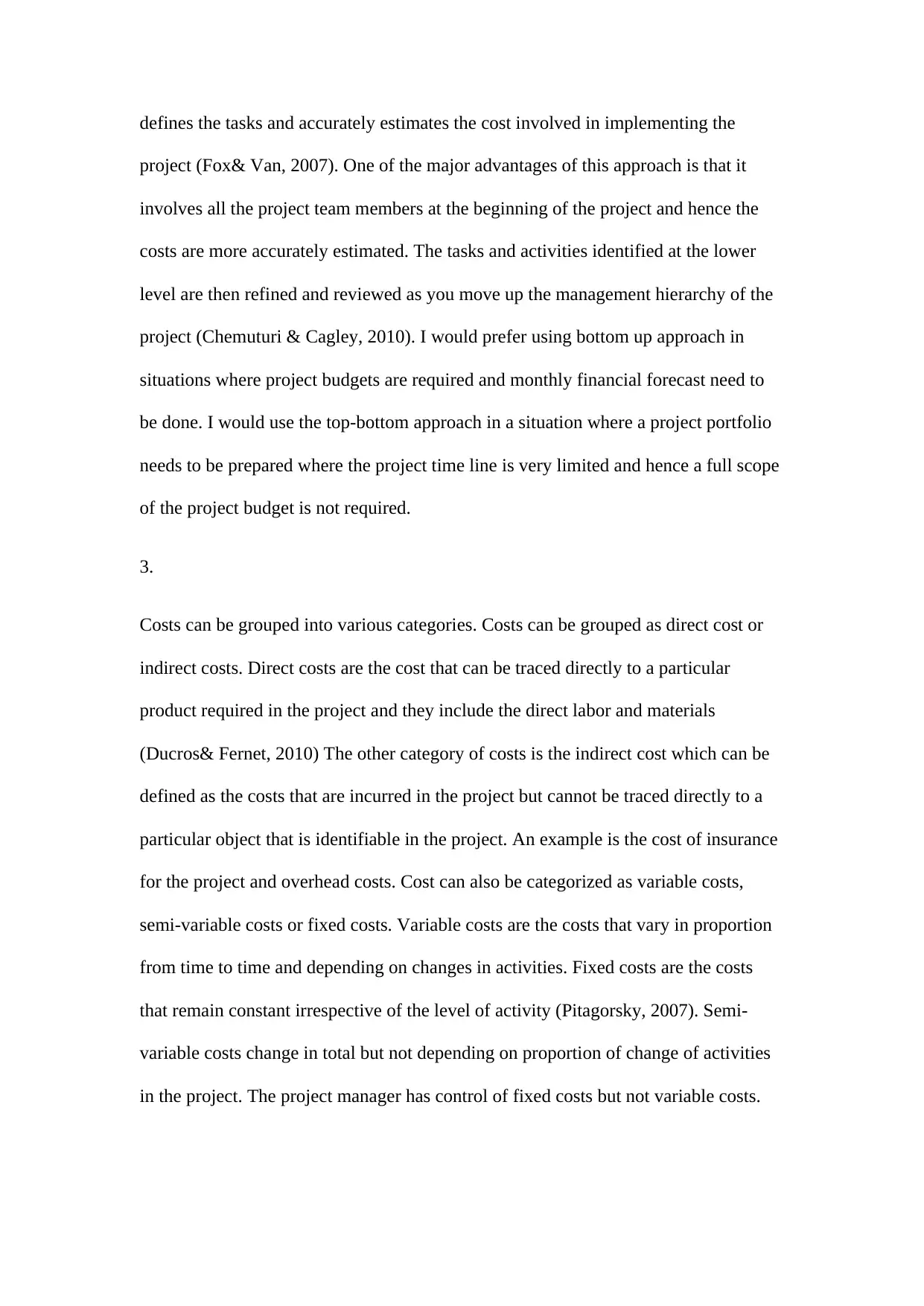
defines the tasks and accurately estimates the cost involved in implementing the
project (Fox& Van, 2007). One of the major advantages of this approach is that it
involves all the project team members at the beginning of the project and hence the
costs are more accurately estimated. The tasks and activities identified at the lower
level are then refined and reviewed as you move up the management hierarchy of the
project (Chemuturi & Cagley, 2010). I would prefer using bottom up approach in
situations where project budgets are required and monthly financial forecast need to
be done. I would use the top-bottom approach in a situation where a project portfolio
needs to be prepared where the project time line is very limited and hence a full scope
of the project budget is not required.
3.
Costs can be grouped into various categories. Costs can be grouped as direct cost or
indirect costs. Direct costs are the cost that can be traced directly to a particular
product required in the project and they include the direct labor and materials
(Ducros& Fernet, 2010) The other category of costs is the indirect cost which can be
defined as the costs that are incurred in the project but cannot be traced directly to a
particular object that is identifiable in the project. An example is the cost of insurance
for the project and overhead costs. Cost can also be categorized as variable costs,
semi-variable costs or fixed costs. Variable costs are the costs that vary in proportion
from time to time and depending on changes in activities. Fixed costs are the costs
that remain constant irrespective of the level of activity (Pitagorsky, 2007). Semi-
variable costs change in total but not depending on proportion of change of activities
in the project. The project manager has control of fixed costs but not variable costs.
project (Fox& Van, 2007). One of the major advantages of this approach is that it
involves all the project team members at the beginning of the project and hence the
costs are more accurately estimated. The tasks and activities identified at the lower
level are then refined and reviewed as you move up the management hierarchy of the
project (Chemuturi & Cagley, 2010). I would prefer using bottom up approach in
situations where project budgets are required and monthly financial forecast need to
be done. I would use the top-bottom approach in a situation where a project portfolio
needs to be prepared where the project time line is very limited and hence a full scope
of the project budget is not required.
3.
Costs can be grouped into various categories. Costs can be grouped as direct cost or
indirect costs. Direct costs are the cost that can be traced directly to a particular
product required in the project and they include the direct labor and materials
(Ducros& Fernet, 2010) The other category of costs is the indirect cost which can be
defined as the costs that are incurred in the project but cannot be traced directly to a
particular object that is identifiable in the project. An example is the cost of insurance
for the project and overhead costs. Cost can also be categorized as variable costs,
semi-variable costs or fixed costs. Variable costs are the costs that vary in proportion
from time to time and depending on changes in activities. Fixed costs are the costs
that remain constant irrespective of the level of activity (Pitagorsky, 2007). Semi-
variable costs change in total but not depending on proportion of change of activities
in the project. The project manager has control of fixed costs but not variable costs.
⊘ This is a preview!⊘
Do you want full access?
Subscribe today to unlock all pages.

Trusted by 1+ million students worldwide
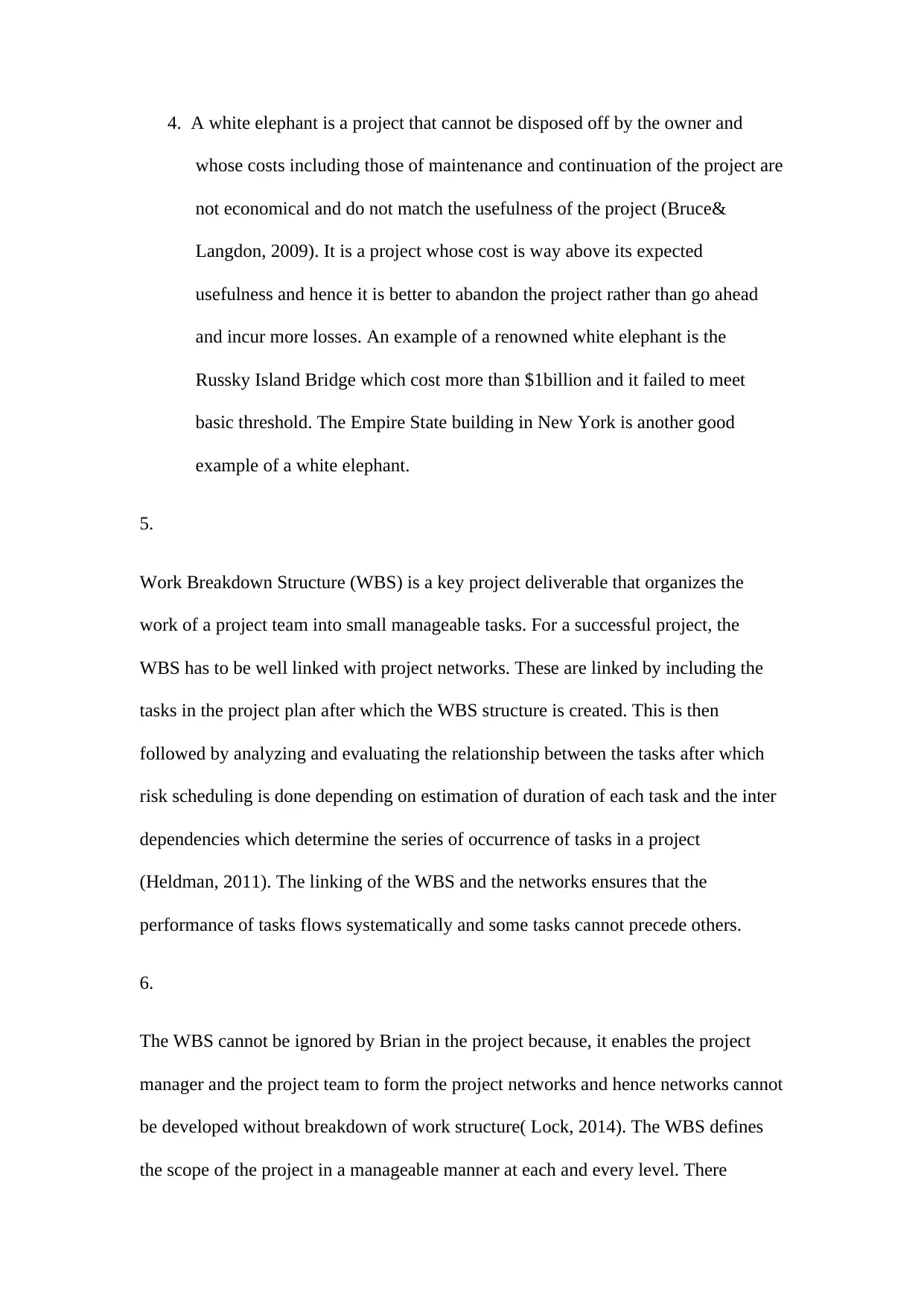
4. A white elephant is a project that cannot be disposed off by the owner and
whose costs including those of maintenance and continuation of the project are
not economical and do not match the usefulness of the project (Bruce&
Langdon, 2009). It is a project whose cost is way above its expected
usefulness and hence it is better to abandon the project rather than go ahead
and incur more losses. An example of a renowned white elephant is the
Russky Island Bridge which cost more than $1billion and it failed to meet
basic threshold. The Empire State building in New York is another good
example of a white elephant.
5.
Work Breakdown Structure (WBS) is a key project deliverable that organizes the
work of a project team into small manageable tasks. For a successful project, the
WBS has to be well linked with project networks. These are linked by including the
tasks in the project plan after which the WBS structure is created. This is then
followed by analyzing and evaluating the relationship between the tasks after which
risk scheduling is done depending on estimation of duration of each task and the inter
dependencies which determine the series of occurrence of tasks in a project
(Heldman, 2011). The linking of the WBS and the networks ensures that the
performance of tasks flows systematically and some tasks cannot precede others.
6.
The WBS cannot be ignored by Brian in the project because, it enables the project
manager and the project team to form the project networks and hence networks cannot
be developed without breakdown of work structure( Lock, 2014). The WBS defines
the scope of the project in a manageable manner at each and every level. There
whose costs including those of maintenance and continuation of the project are
not economical and do not match the usefulness of the project (Bruce&
Langdon, 2009). It is a project whose cost is way above its expected
usefulness and hence it is better to abandon the project rather than go ahead
and incur more losses. An example of a renowned white elephant is the
Russky Island Bridge which cost more than $1billion and it failed to meet
basic threshold. The Empire State building in New York is another good
example of a white elephant.
5.
Work Breakdown Structure (WBS) is a key project deliverable that organizes the
work of a project team into small manageable tasks. For a successful project, the
WBS has to be well linked with project networks. These are linked by including the
tasks in the project plan after which the WBS structure is created. This is then
followed by analyzing and evaluating the relationship between the tasks after which
risk scheduling is done depending on estimation of duration of each task and the inter
dependencies which determine the series of occurrence of tasks in a project
(Heldman, 2011). The linking of the WBS and the networks ensures that the
performance of tasks flows systematically and some tasks cannot precede others.
6.
The WBS cannot be ignored by Brian in the project because, it enables the project
manager and the project team to form the project networks and hence networks cannot
be developed without breakdown of work structure( Lock, 2014). The WBS defines
the scope of the project in a manageable manner at each and every level. There
Paraphrase This Document
Need a fresh take? Get an instant paraphrase of this document with our AI Paraphraser
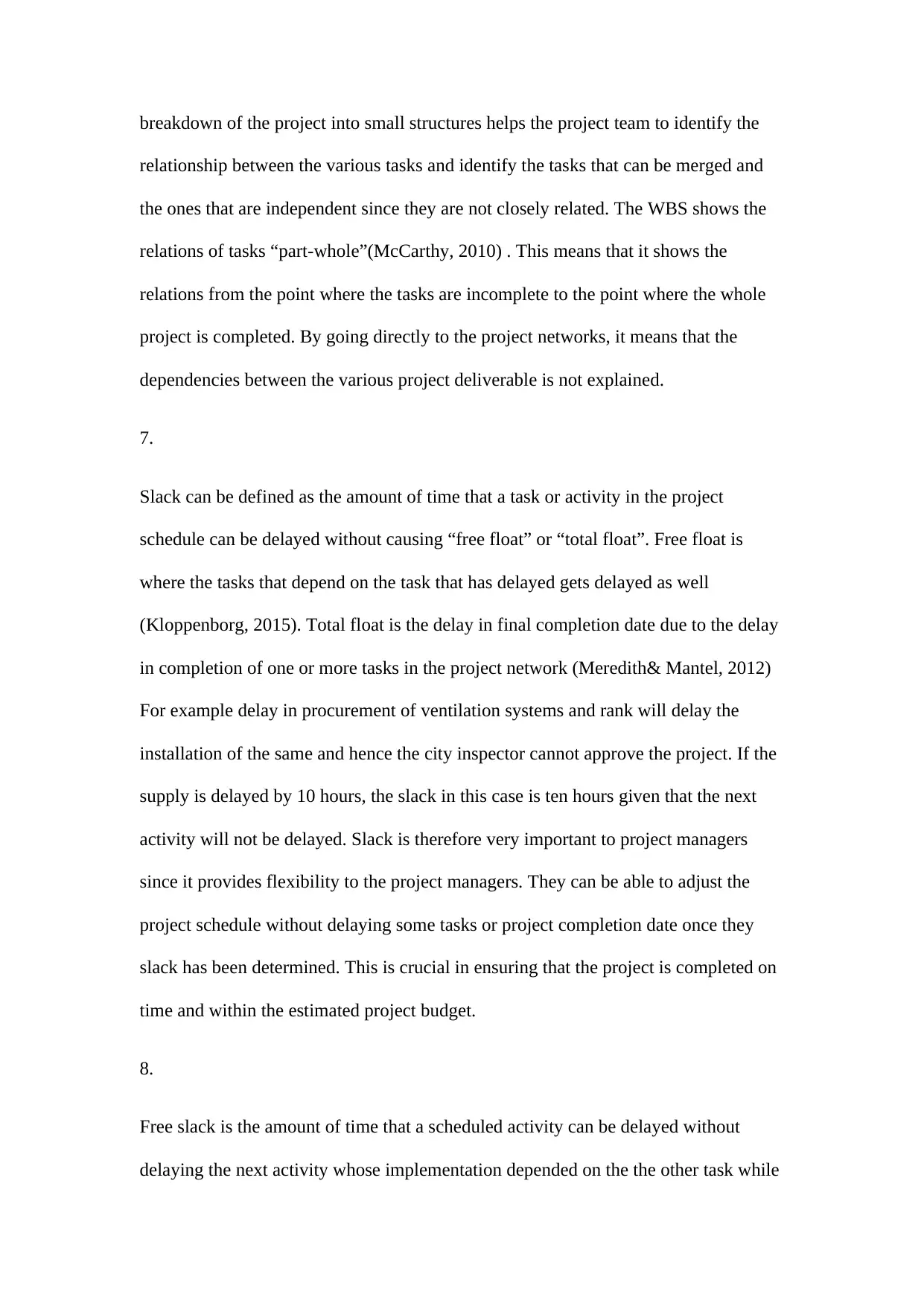
breakdown of the project into small structures helps the project team to identify the
relationship between the various tasks and identify the tasks that can be merged and
the ones that are independent since they are not closely related. The WBS shows the
relations of tasks “part-whole”(McCarthy, 2010) . This means that it shows the
relations from the point where the tasks are incomplete to the point where the whole
project is completed. By going directly to the project networks, it means that the
dependencies between the various project deliverable is not explained.
7.
Slack can be defined as the amount of time that a task or activity in the project
schedule can be delayed without causing “free float” or “total float”. Free float is
where the tasks that depend on the task that has delayed gets delayed as well
(Kloppenborg, 2015). Total float is the delay in final completion date due to the delay
in completion of one or more tasks in the project network (Meredith& Mantel, 2012)
For example delay in procurement of ventilation systems and rank will delay the
installation of the same and hence the city inspector cannot approve the project. If the
supply is delayed by 10 hours, the slack in this case is ten hours given that the next
activity will not be delayed. Slack is therefore very important to project managers
since it provides flexibility to the project managers. They can be able to adjust the
project schedule without delaying some tasks or project completion date once they
slack has been determined. This is crucial in ensuring that the project is completed on
time and within the estimated project budget.
8.
Free slack is the amount of time that a scheduled activity can be delayed without
delaying the next activity whose implementation depended on the the other task while
relationship between the various tasks and identify the tasks that can be merged and
the ones that are independent since they are not closely related. The WBS shows the
relations of tasks “part-whole”(McCarthy, 2010) . This means that it shows the
relations from the point where the tasks are incomplete to the point where the whole
project is completed. By going directly to the project networks, it means that the
dependencies between the various project deliverable is not explained.
7.
Slack can be defined as the amount of time that a task or activity in the project
schedule can be delayed without causing “free float” or “total float”. Free float is
where the tasks that depend on the task that has delayed gets delayed as well
(Kloppenborg, 2015). Total float is the delay in final completion date due to the delay
in completion of one or more tasks in the project network (Meredith& Mantel, 2012)
For example delay in procurement of ventilation systems and rank will delay the
installation of the same and hence the city inspector cannot approve the project. If the
supply is delayed by 10 hours, the slack in this case is ten hours given that the next
activity will not be delayed. Slack is therefore very important to project managers
since it provides flexibility to the project managers. They can be able to adjust the
project schedule without delaying some tasks or project completion date once they
slack has been determined. This is crucial in ensuring that the project is completed on
time and within the estimated project budget.
8.
Free slack is the amount of time that a scheduled activity can be delayed without
delaying the next activity whose implementation depended on the the other task while
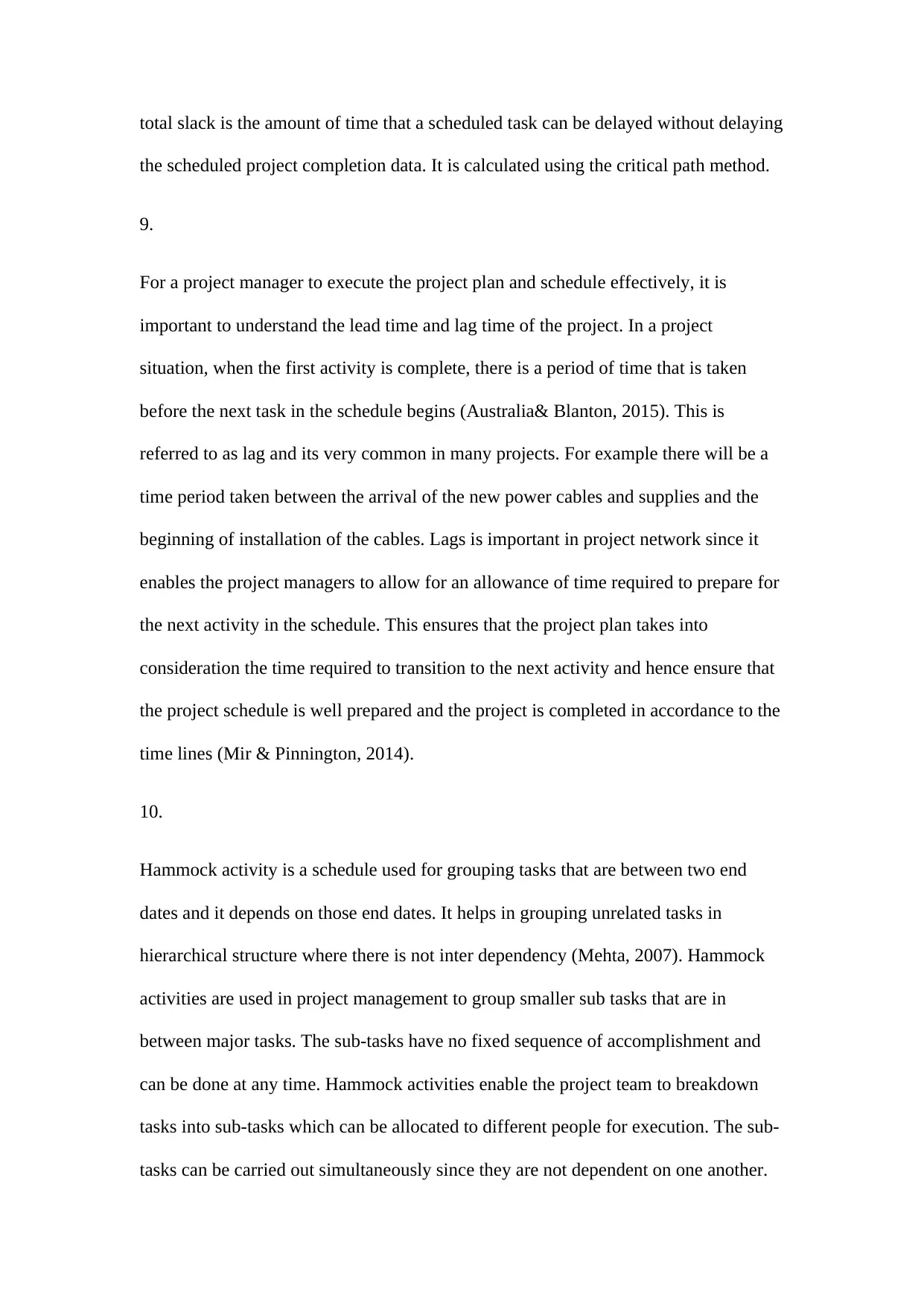
total slack is the amount of time that a scheduled task can be delayed without delaying
the scheduled project completion data. It is calculated using the critical path method.
9.
For a project manager to execute the project plan and schedule effectively, it is
important to understand the lead time and lag time of the project. In a project
situation, when the first activity is complete, there is a period of time that is taken
before the next task in the schedule begins (Australia& Blanton, 2015). This is
referred to as lag and its very common in many projects. For example there will be a
time period taken between the arrival of the new power cables and supplies and the
beginning of installation of the cables. Lags is important in project network since it
enables the project managers to allow for an allowance of time required to prepare for
the next activity in the schedule. This ensures that the project plan takes into
consideration the time required to transition to the next activity and hence ensure that
the project schedule is well prepared and the project is completed in accordance to the
time lines (Mir & Pinnington, 2014).
10.
Hammock activity is a schedule used for grouping tasks that are between two end
dates and it depends on those end dates. It helps in grouping unrelated tasks in
hierarchical structure where there is not inter dependency (Mehta, 2007). Hammock
activities are used in project management to group smaller sub tasks that are in
between major tasks. The sub-tasks have no fixed sequence of accomplishment and
can be done at any time. Hammock activities enable the project team to breakdown
tasks into sub-tasks which can be allocated to different people for execution. The sub-
tasks can be carried out simultaneously since they are not dependent on one another.
the scheduled project completion data. It is calculated using the critical path method.
9.
For a project manager to execute the project plan and schedule effectively, it is
important to understand the lead time and lag time of the project. In a project
situation, when the first activity is complete, there is a period of time that is taken
before the next task in the schedule begins (Australia& Blanton, 2015). This is
referred to as lag and its very common in many projects. For example there will be a
time period taken between the arrival of the new power cables and supplies and the
beginning of installation of the cables. Lags is important in project network since it
enables the project managers to allow for an allowance of time required to prepare for
the next activity in the schedule. This ensures that the project plan takes into
consideration the time required to transition to the next activity and hence ensure that
the project schedule is well prepared and the project is completed in accordance to the
time lines (Mir & Pinnington, 2014).
10.
Hammock activity is a schedule used for grouping tasks that are between two end
dates and it depends on those end dates. It helps in grouping unrelated tasks in
hierarchical structure where there is not inter dependency (Mehta, 2007). Hammock
activities are used in project management to group smaller sub tasks that are in
between major tasks. The sub-tasks have no fixed sequence of accomplishment and
can be done at any time. Hammock activities enable the project team to breakdown
tasks into sub-tasks which can be allocated to different people for execution. The sub-
tasks can be carried out simultaneously since they are not dependent on one another.
⊘ This is a preview!⊘
Do you want full access?
Subscribe today to unlock all pages.

Trusted by 1+ million students worldwide
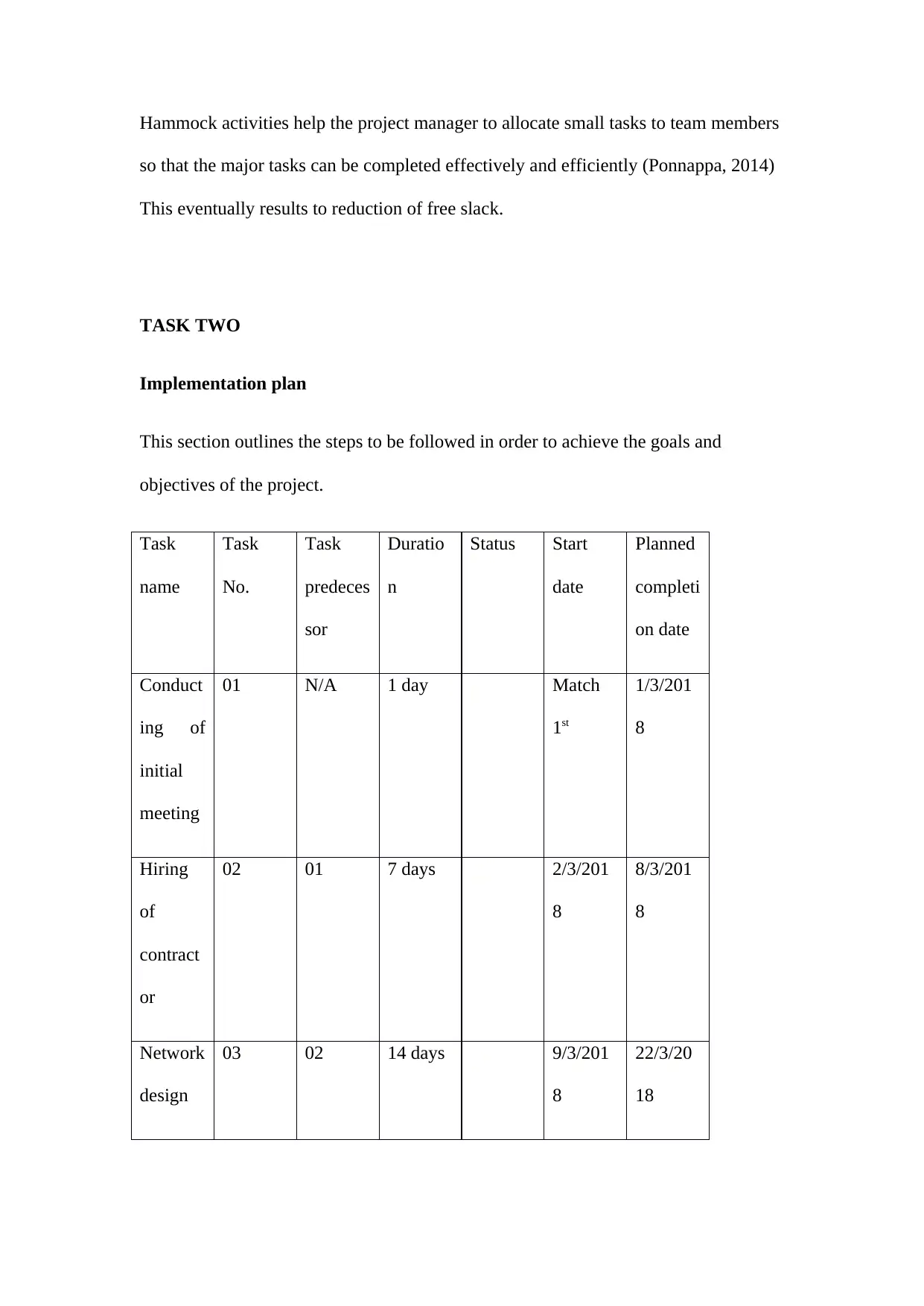
Hammock activities help the project manager to allocate small tasks to team members
so that the major tasks can be completed effectively and efficiently (Ponnappa, 2014)
This eventually results to reduction of free slack.
TASK TWO
Implementation plan
This section outlines the steps to be followed in order to achieve the goals and
objectives of the project.
Task
name
Task
No.
Task
predeces
sor
Duratio
n
Status Start
date
Planned
completi
on date
Conduct
ing of
initial
meeting
01 N/A 1 day Match
1st
1/3/201
8
Hiring
of
contract
or
02 01 7 days 2/3/201
8
8/3/201
8
Network
design
03 02 14 days 9/3/201
8
22/3/20
18
so that the major tasks can be completed effectively and efficiently (Ponnappa, 2014)
This eventually results to reduction of free slack.
TASK TWO
Implementation plan
This section outlines the steps to be followed in order to achieve the goals and
objectives of the project.
Task
name
Task
No.
Task
predeces
sor
Duratio
n
Status Start
date
Planned
completi
on date
Conduct
ing of
initial
meeting
01 N/A 1 day Match
1st
1/3/201
8
Hiring
of
contract
or
02 01 7 days 2/3/201
8
8/3/201
8
Network
design
03 02 14 days 9/3/201
8
22/3/20
18
Paraphrase This Document
Need a fresh take? Get an instant paraphrase of this document with our AI Paraphraser

Procurin
g new
servers
,switche
s ,racks
and
network
devices
04 03 14 days 23/3/20
18
5/4/201
8
Procure
ment of
power
supplies
and data
cables
05 04 7 days 6/4/201
8
12/4/20
18
Installati
on of
ventilati
on
system
06 05 7 days 13/4/20
18
19/4/20
28
Installati
on of
racks
07 06 21 days 20/4/20
18
10/5/20
18
Renovat
ion of
08 07 20 days 11/5/20 30/5/20
g new
servers
,switche
s ,racks
and
network
devices
04 03 14 days 23/3/20
18
5/4/201
8
Procure
ment of
power
supplies
and data
cables
05 04 7 days 6/4/201
8
12/4/20
18
Installati
on of
ventilati
on
system
06 05 7 days 13/4/20
18
19/4/20
28
Installati
on of
racks
07 06 21 days 20/4/20
18
10/5/20
18
Renovat
ion of
08 07 20 days 11/5/20 30/5/20

data
center
18 18
Inspecti
on of
the
project
by city
inspecto
r
09 08 2 days 31/5/20
18
1/6/201
8
Installati
on of
data
cables
10 09 5 days 2/6/201
8
6/6/201
8
Running
of data
cables
11 10 7days 7/6/201
8
13/6/20
18
Meeting
s with
function
al units
12 Simulta
neous
21 days 14/6/20
18
4/7/201
8
Power
check
13 Simulta
neous
1 day 4/7/201
8
4/7/201
8
Installati 14 13 &12 7 days 5/7/201 11/7/20
center
18 18
Inspecti
on of
the
project
by city
inspecto
r
09 08 2 days 31/5/20
18
1/6/201
8
Installati
on of
data
cables
10 09 5 days 2/6/201
8
6/6/201
8
Running
of data
cables
11 10 7days 7/6/201
8
13/6/20
18
Meeting
s with
function
al units
12 Simulta
neous
21 days 14/6/20
18
4/7/201
8
Power
check
13 Simulta
neous
1 day 4/7/201
8
4/7/201
8
Installati 14 13 &12 7 days 5/7/201 11/7/20
⊘ This is a preview!⊘
Do you want full access?
Subscribe today to unlock all pages.

Trusted by 1+ million students worldwide

on of
test
servers
8 18
Chargin
g
batteries
and
review
of
systems
and
network
15 14 2 days 12/7/20
18
13/7/20
18
Checkin
g off
primary
systems
and
meeting
s
16 15 1 day 14/7/20
18
14/7/20
18
Moving
network
compon
ents to
new
17 16 2 days 15/7/20
18
16/7/20
18
test
servers
8 18
Chargin
g
batteries
and
review
of
systems
and
network
15 14 2 days 12/7/20
18
13/7/20
18
Checkin
g off
primary
systems
and
meeting
s
16 15 1 day 14/7/20
18
14/7/20
18
Moving
network
compon
ents to
new
17 16 2 days 15/7/20
18
16/7/20
18
Paraphrase This Document
Need a fresh take? Get an instant paraphrase of this document with our AI Paraphraser
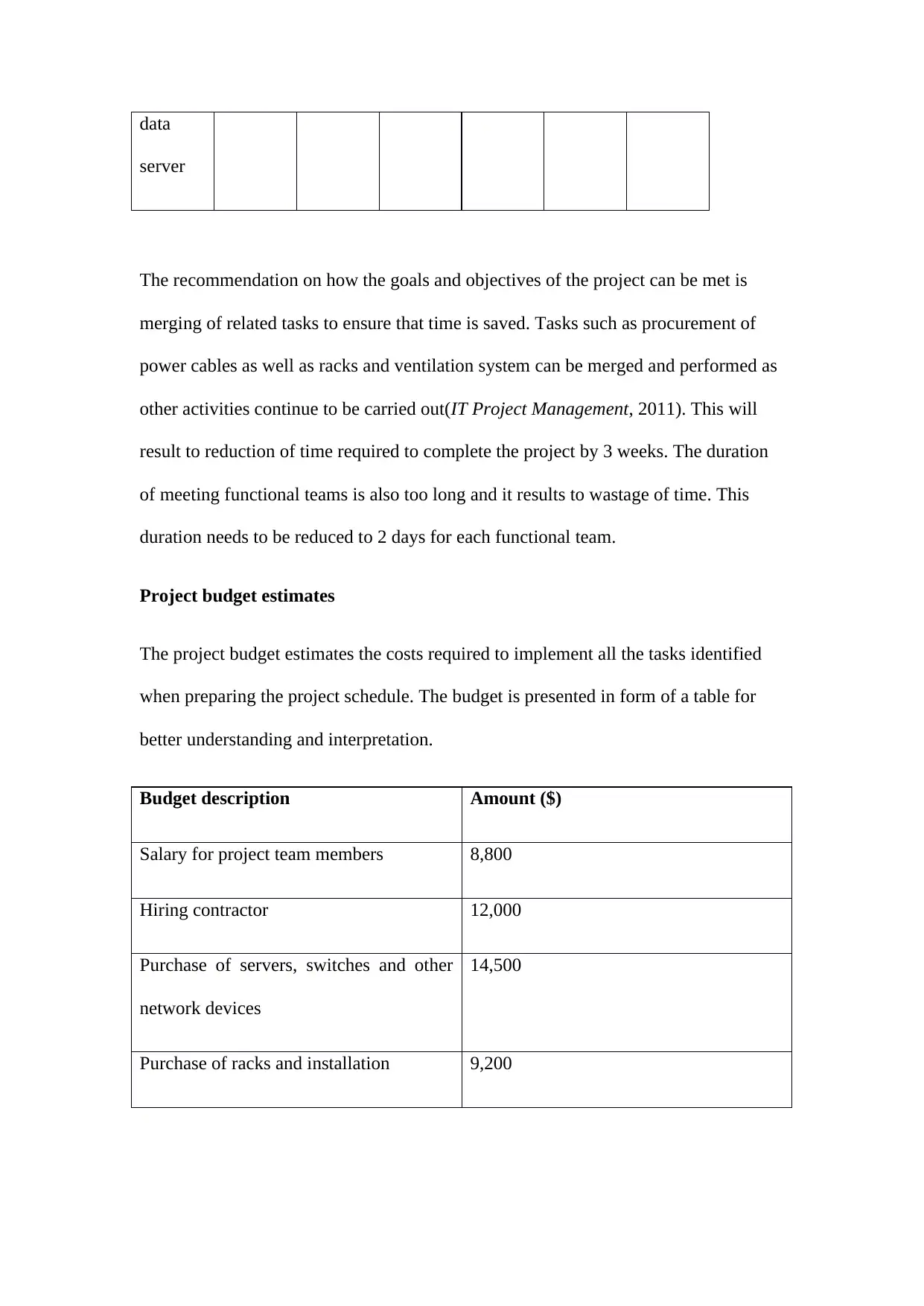
data
server
The recommendation on how the goals and objectives of the project can be met is
merging of related tasks to ensure that time is saved. Tasks such as procurement of
power cables as well as racks and ventilation system can be merged and performed as
other activities continue to be carried out(IT Project Management, 2011). This will
result to reduction of time required to complete the project by 3 weeks. The duration
of meeting functional teams is also too long and it results to wastage of time. This
duration needs to be reduced to 2 days for each functional team.
Project budget estimates
The project budget estimates the costs required to implement all the tasks identified
when preparing the project schedule. The budget is presented in form of a table for
better understanding and interpretation.
Budget description Amount ($)
Salary for project team members 8,800
Hiring contractor 12,000
Purchase of servers, switches and other
network devices
14,500
Purchase of racks and installation 9,200
server
The recommendation on how the goals and objectives of the project can be met is
merging of related tasks to ensure that time is saved. Tasks such as procurement of
power cables as well as racks and ventilation system can be merged and performed as
other activities continue to be carried out(IT Project Management, 2011). This will
result to reduction of time required to complete the project by 3 weeks. The duration
of meeting functional teams is also too long and it results to wastage of time. This
duration needs to be reduced to 2 days for each functional team.
Project budget estimates
The project budget estimates the costs required to implement all the tasks identified
when preparing the project schedule. The budget is presented in form of a table for
better understanding and interpretation.
Budget description Amount ($)
Salary for project team members 8,800
Hiring contractor 12,000
Purchase of servers, switches and other
network devices
14,500
Purchase of racks and installation 9,200
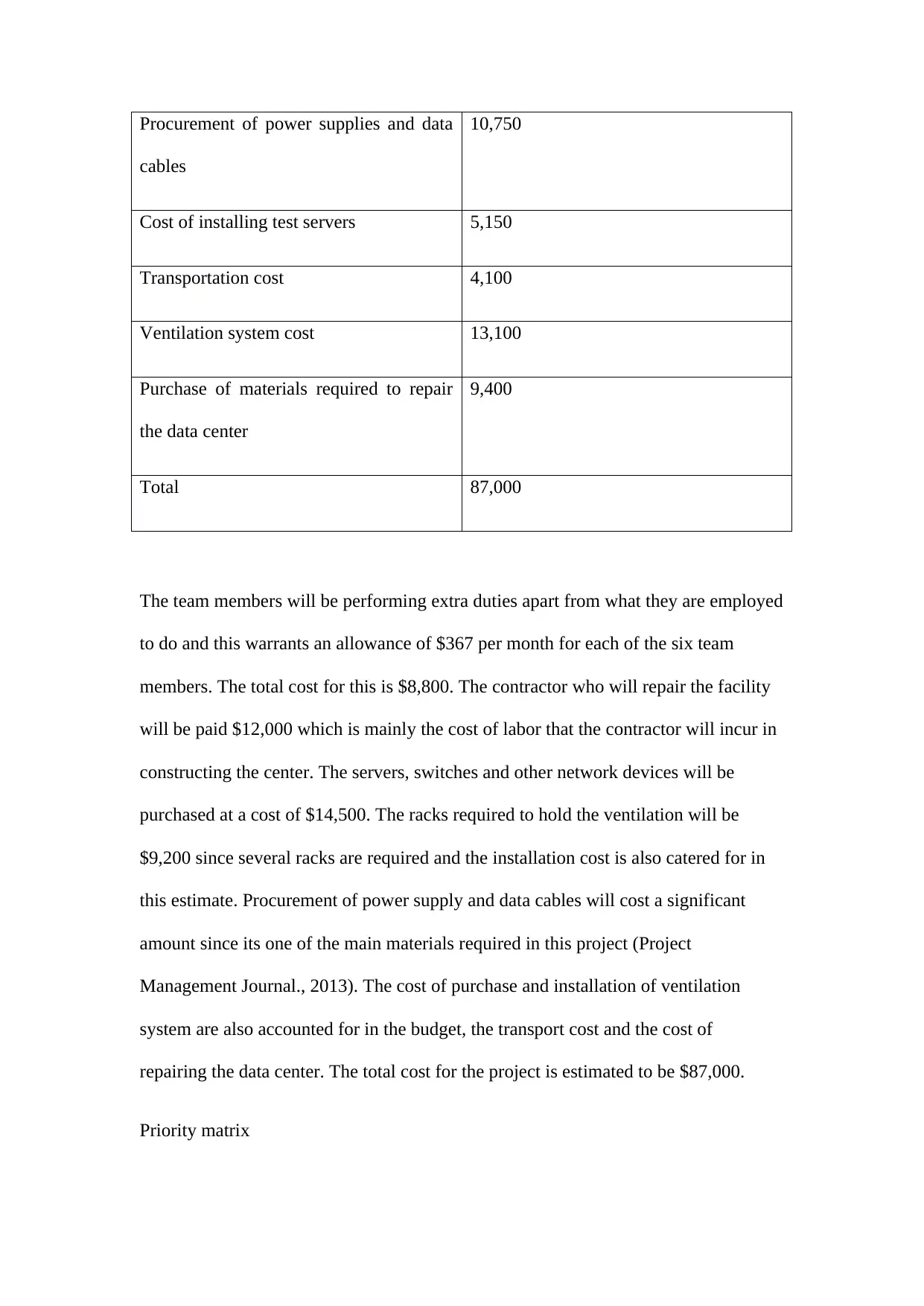
Procurement of power supplies and data
cables
10,750
Cost of installing test servers 5,150
Transportation cost 4,100
Ventilation system cost 13,100
Purchase of materials required to repair
the data center
9,400
Total 87,000
The team members will be performing extra duties apart from what they are employed
to do and this warrants an allowance of $367 per month for each of the six team
members. The total cost for this is $8,800. The contractor who will repair the facility
will be paid $12,000 which is mainly the cost of labor that the contractor will incur in
constructing the center. The servers, switches and other network devices will be
purchased at a cost of $14,500. The racks required to hold the ventilation will be
$9,200 since several racks are required and the installation cost is also catered for in
this estimate. Procurement of power supply and data cables will cost a significant
amount since its one of the main materials required in this project (Project
Management Journal., 2013). The cost of purchase and installation of ventilation
system are also accounted for in the budget, the transport cost and the cost of
repairing the data center. The total cost for the project is estimated to be $87,000.
Priority matrix
cables
10,750
Cost of installing test servers 5,150
Transportation cost 4,100
Ventilation system cost 13,100
Purchase of materials required to repair
the data center
9,400
Total 87,000
The team members will be performing extra duties apart from what they are employed
to do and this warrants an allowance of $367 per month for each of the six team
members. The total cost for this is $8,800. The contractor who will repair the facility
will be paid $12,000 which is mainly the cost of labor that the contractor will incur in
constructing the center. The servers, switches and other network devices will be
purchased at a cost of $14,500. The racks required to hold the ventilation will be
$9,200 since several racks are required and the installation cost is also catered for in
this estimate. Procurement of power supply and data cables will cost a significant
amount since its one of the main materials required in this project (Project
Management Journal., 2013). The cost of purchase and installation of ventilation
system are also accounted for in the budget, the transport cost and the cost of
repairing the data center. The total cost for the project is estimated to be $87,000.
Priority matrix
⊘ This is a preview!⊘
Do you want full access?
Subscribe today to unlock all pages.

Trusted by 1+ million students worldwide
1 out of 18
Related Documents
Your All-in-One AI-Powered Toolkit for Academic Success.
+13062052269
info@desklib.com
Available 24*7 on WhatsApp / Email
![[object Object]](/_next/static/media/star-bottom.7253800d.svg)
Unlock your academic potential
Copyright © 2020–2025 A2Z Services. All Rights Reserved. Developed and managed by ZUCOL.





